Scuba Diving in Maui and Lanai, Hawaii
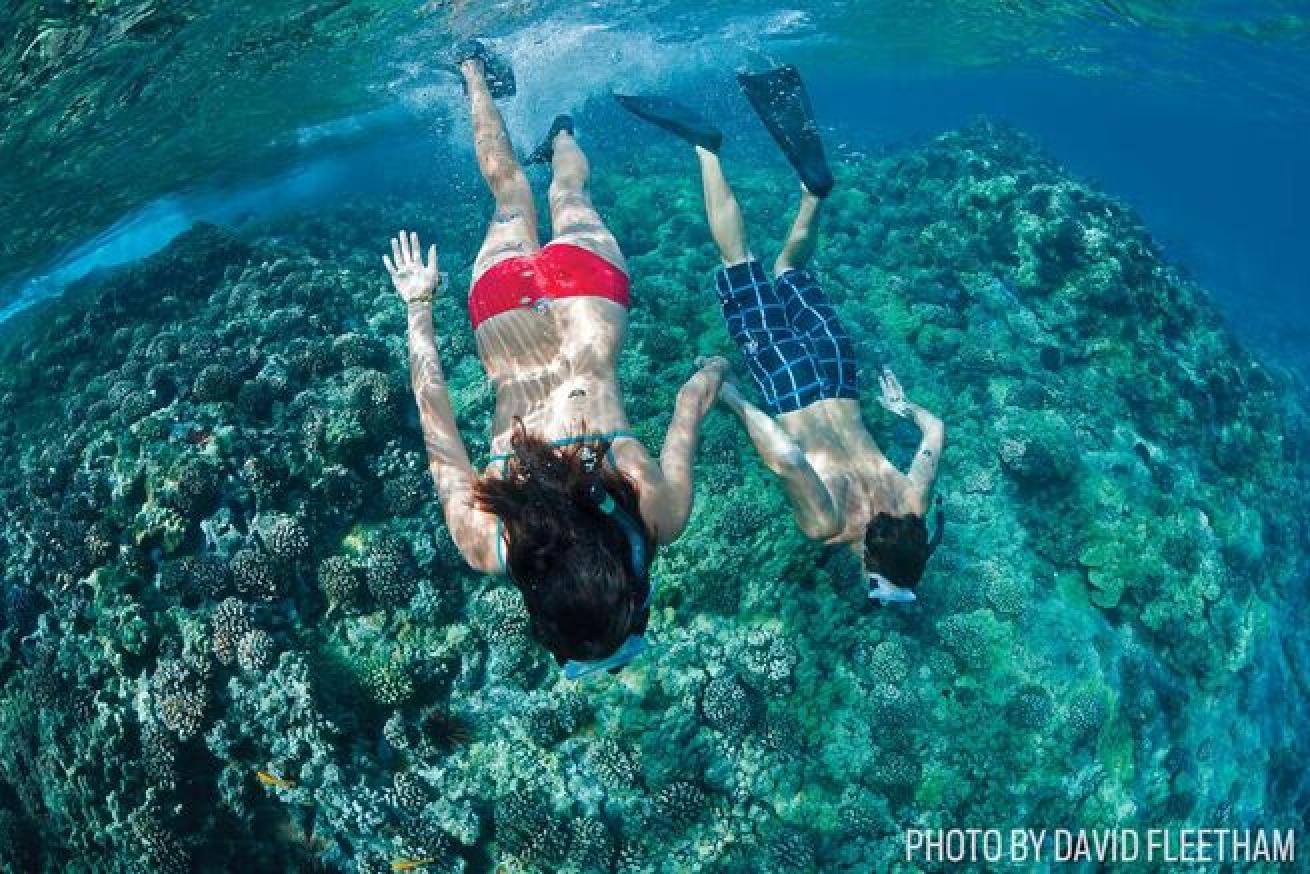
David FleethamA couple free diving at Molokini Marine Preserve off the island of Maui, Hawaii
At dawn on my first morning at Ka’anapali Beach, I push open the curtains and step out onto my oceanfront balcony, where Maui’s lure becomes immediately apparent — there’s a double rainbow over the ocean, ending seemingly right in front of my hotel. After a quick breakfast, I’m ready to explore what lies at that rainbow’s end and go scuba diving in Maui with Dive Maui.
I had arrived the evening before and saw little of the “ Valley Isle” or the lovely planned community where I’m staying, Aston Ka’anapali Shores, about 5 miles north of the old whaling port of Lahaina. Travel never seems to go according to plan, and my arrival on Maui is no different. A 1 p.m. flight turned into a 9 p.m. one, so I navigated the hilly roads to the hotel, on the island’s northwest coast, in the dark.
Friends who knew I was visiting spoke reverentially about the island and the spell it cast upon them — the underwater landscape I’d come to explore, the lush, rolling hills, the soaring Haleakalā volcano and the winding Road to Hana, twisting its way through a rainforest on the northeast coast. I can’t wait to discover this magical island for myself.

David FleethamDivers, pictured at the entrance to First Cathedral off the Island of Lanai, Hawaii
GOING TO CHURCH
I show up at the cozy Front Street shop in Lahaina at 7:45 a.m. on the dot and find that I’m the last one there. The rest of the day’s group, hailing from all points mainland, as well as our captain, Steve Butler, and the shop owner (and guide) Capt. Steve Juarez head out to the coast of Lanai for the day’s dives onboard Hoku, a 37-foot rigid-hull inflatable. Much of Maui’s best diving is, in fact, off the south shore of Lanai — a former pineapple plantation about 8 miles due west of Maui — including the famed sites First Cathedral and Second Cathedral. It’s about a 40-minute boat ride before we near the largely undeveloped coast. The highlight is our second dive, when we splash in at Second Cathedral, a huge underwater cavern with lots of swim-throughs and archways.
“I always do it as a second dive,” says Juarez. “When the sun’s directly overhead, there’s more light rays inside. It looks like a spotlight shining down in the cavern.”
During the briefing, we learn that Second Cathedral has huge schools of blue-striped snapper. “The local name is taape,” says Juarez. “As you swim into the schools, they spread out like a giant yellow ribbon several hundred yards long over the top of the reef — it’s beautiful for photos and video.”
As we drop down, as forecasted, curtains of bluestriped snapper part, plus Moorish idols and raccoon butterflyfish abound. As we enter the dark cavern for which the site is named, light pierces the holes in the ceiling and falls in beams to the ocean floor. A 6-foot black coral hangs from the cavern’s ceiling like a chandelier. These rare corals can be more than a thousand years old, and are usually found in deeper water. The filter-feeding coral “thrives here because the cavern is dark and there’s just the right amount of surge bringing nutrients in,” says Juarez.
On our surface interval, I chat a bit with Butler, who originally came to Maui from northern California. “I came out to visit my little brother for a few weeks,” he says. “That was eight years ago.”
It’s a story I’ll hear again and again during my stay: Maui is what happens when you’re busy making other plans. That night, my waiter at the lively Hula Grill tells me the legend of the demigod Maui, who used his magical fishing lure to pull the islands of the Hawaiian chain from the bottom of the ocean. As the crowd chats happily, the breeze rustles the palm trees, the sun sets over the water and the band covers Elton John, I can feel the hook sinking in as well.
Related Reading: How to Dive Maui Without Breaking the Bank
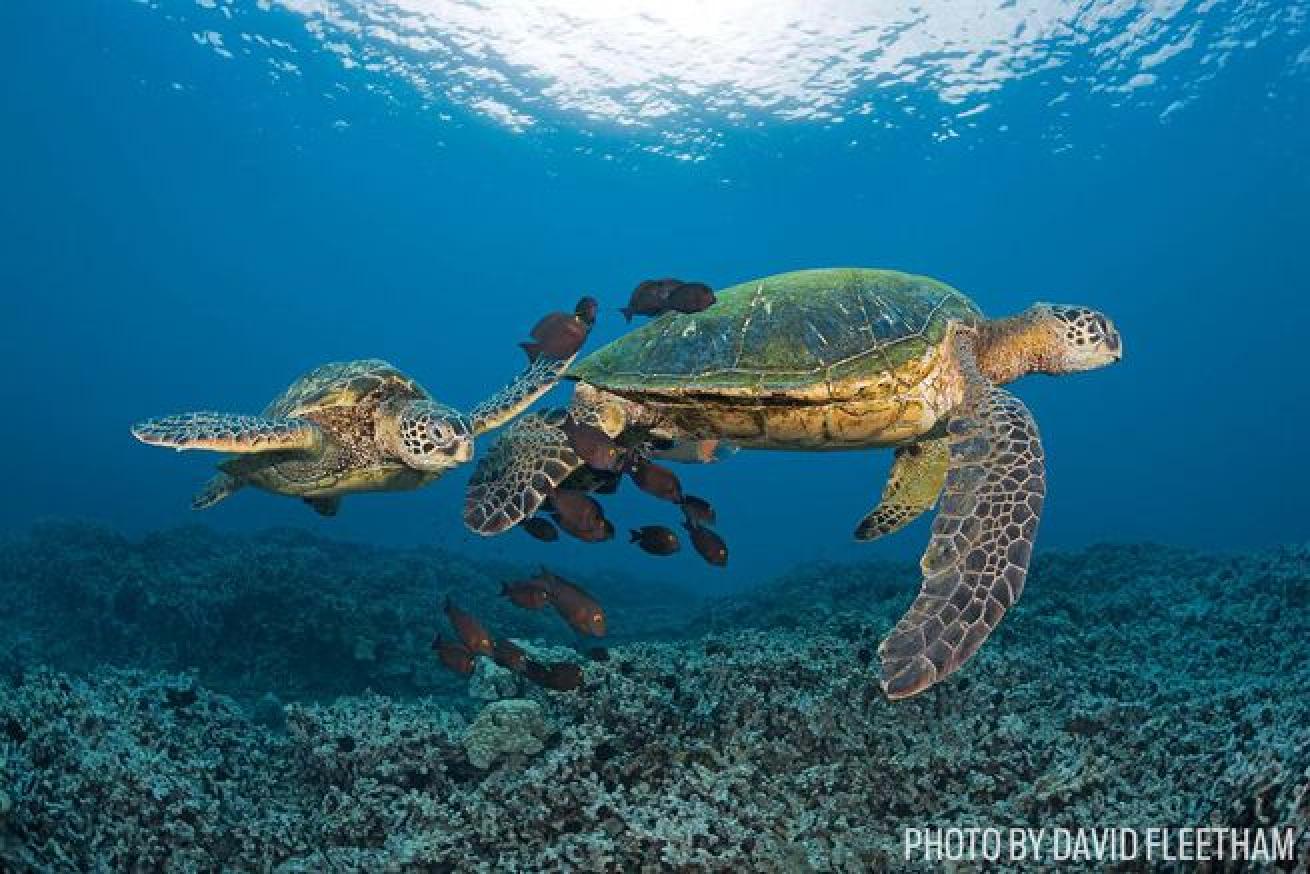
David FleethamGreen sea turtles have their shells cleaned by a school of goldring surgeonfish off Maui, Hawaii
THE WAY TO NEVER-NEVER LAND
The next morning brings another early wake-up call. Today’s sites include two more of Maui’s best: First Cathedral and Monolith. We visit Monolith — one of Juarez’s favorite sites — first. It’s a pinnacle that begins about 45 feet from the surface and drops away to around 110 below. There’s another pinnacle at the site too — “We call it Never-Never Land because we never, never bring tourists out here,” jokes Juarez. The site is deep and subject to strong currents, but he’s judged today’s divers capable, and we drop down to about 80 feet on Monolith. He wasn’t kidding about the current, and after 10 minutes on the first structure, where we spot long-nose hawkfish nestled next to gorgonian fans, we tuck in and power across the sand to Never-Never Land, where we check out a black coral at about 100 feet and where another long-nose hawkfish awaits. Juarez had briefed us about the endemic longfin anthias that have made Never-Never Land home. “These are beautiful fish, and you’ll find a male with a harem of nine or 10 females, and a few feet later, there will be another male, also with a harem. If they get too close, they’ll fight; they’re protective of their territories.”
Sure enough, the colorful (bright orange, yellow, blue, magenta, red and purple!) anthias are where Juarez told us to find them, each male protecting his turf and harem. The viz is nearly bottle-glass-clear as we turn around to head back to Monolith; ahead of us, two eagle rays wing across the sand.
For the same reason Juarez dives Second Cathedral later in the morning, we’re diving First Cathedral as our second dive. And like its sister site, First Cathedral is aptly named. “Some of us even got married in there,” Juarez says. “Part of the roof collapsed, and the big lava rock that fell to the floor of the cavern is what we call the Altar.” On Jan. 5, 2015, Steve exchanged wedding vows with his wife, Robin, here.
We don’t crash any weddings today inside the underwater lava tube, but we do spot countless schooling raccoon butterflyfish, angelfish and nudibranchs. Juarez signals to the group, as if he’s flicking a cigarette lighter — he’s spotted a flame angelfish.
“Flame angels were hunted by the fish collectors for the mainland aquarium trade and are almost extinct here,” Juarez tells me later. “Maui County regulated the fish collectors out of business, and now we are starting to see more flame angels on our dive sites. They are very shy and hard to photograph because they hide in the corals.”
Another lovely aspect to this dive is a lava tube called Shotgun or Torpedo Tube. When you time the surge right, the group can shotgun, one at a time, through a hole in the main cavern’s back wall.
This site’s resemblance to a cathedral doesn’t end with its architectural similarity. The abundance of marine life is like the choir belting out the “Hallelujah” chorus: turtles, tons of fish, including endemic bandit angelfish, along the outside walls of the cavern. Nudibranchs shelter in the bright pink and orange cup corals that cover the roof of one of the swim-through openings. Everywhere you look, there’s an explosion of color, activity and the glorious play of sunbeams on dark lava walls.
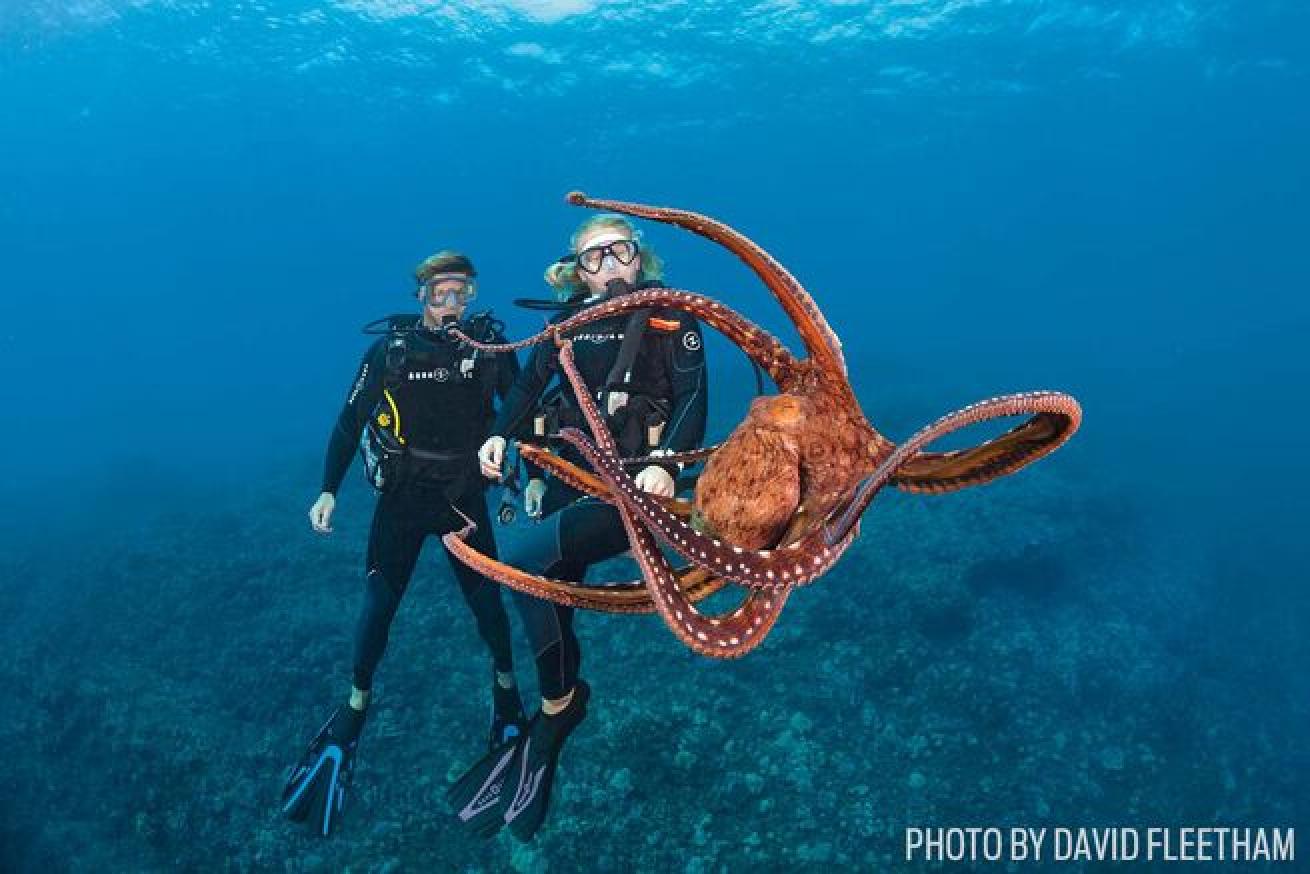
David FleethamDivers look on at a day octopus in Hawaii
PARADISE LOST, AGAIN
The next morning it’s time to pull up stakes and head south to Wailea, a resort area on Maui’s west coast, but not before a slight detour. It’s hard to get lost on an island, but I somehow manage it. A late-afternoon arrival and a GPS address that sends me to a closed office means I’m meandering through developments, searching for the right spot. I crest a hill — on the right track now, I think — as the sun is setting over the ocean behind me. There are worse spots to be lost, and any irritation I might have felt melts away with the realization that I would have missed (another) glorious sunset had I found my way sooner.
I pull up a bar stool that evening at Monkeypod Kitchen, a gastropub with 36 craft brews on tap and a r ocking live band. I order the burnt Maui pineapple and cashew salad, all ingredients sourced locally, and strike up a conversation with the bartender, who — no surprise — came here on vacation and never left.
After a restful night in my Maui Ekahi Village condo (found it!), I head to Maalaea Harbor to board Maui Diamond II with Maui Dreams Dive Company. I’ve already knocked off First and Second cathedrals; now it’s time to dive famed Molokini Crater. I board the boat around 6:30 in the morning with another eager group of divers.
Related Reading: 7 Best Wrecks to Dive in Oahu, Hawaii
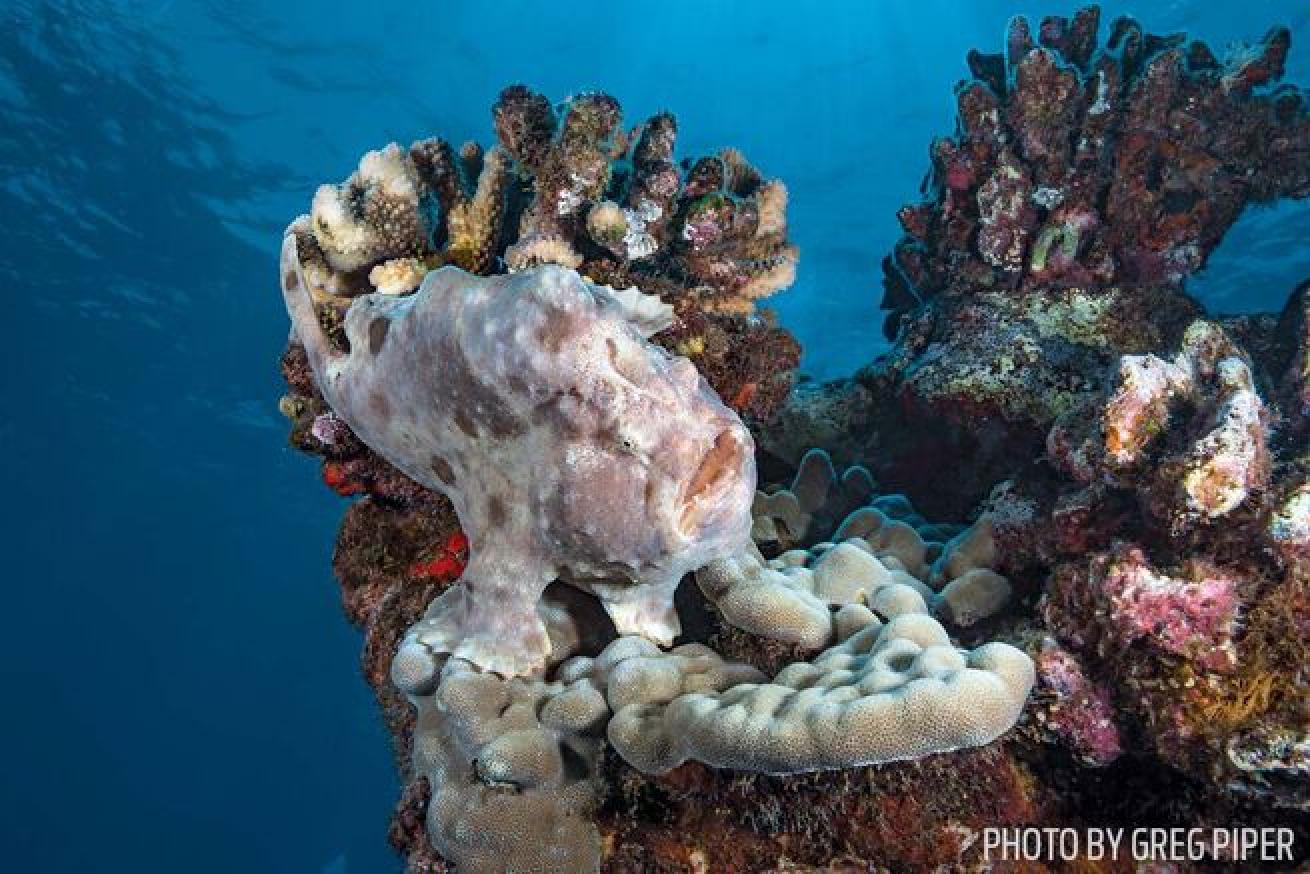
Greg PiperA frogfish off the coast of Lanai, Hawaii
It takes about 45 minutes to get out to Molokini, which is already crowded with boats early in the morning. The crescentshaped, partially submerged volcanic crater is all that remains of one of seven prehistoric volcanoes, and it’s now a marine and bird sanctuary. Experienced divers can drift along the back wall of Molokini, spotting everything from whitetip reef sharks to passing mantas, but today’s agenda calls for a long, leisurely dive in Molokini’s protected bay. The shallow, hard-coral garden, with average dive depths of only about 50 feet, is home to more than 250 species of fish. Our group drops into crystal-clear waters and levels out at about 40 feet. Visibility over the garden is amazing — at least 100 feet — and I see black triggerfish, a day octopus, moray eels, and schools of yellow tang and threadfin butterflyfish.
Back on the boat for the surface interval and chatting with Teri White, the dive-shop manager, a feeling of déjà vu comes over me. “I came out 17 years ago for two weeks’ vacation, faxed in my resignation, and never went back,” she says. We’re sitting on the boat’s upper deck, motoring over to Wailea Point for our second dive of the day, and it’s not hard to see why she never even returned to the mainland for her clothes. The hills behind Kihei glow with a lush green in the midmorning sun; there are a few snorkelers and stand-up paddleboarders in the water; and someone thinks they just saw dolphins. Even the Maui mantas stick around the island, White tells me. None of the identified 300 animals has ever been spotted on Kona or vice versa, most likely owing to the 30-mile-wide, 6,100-foot-deep channel separating the islands.
The next day, back on board, we stick closer to shore, diving the Triple Anchors and Helldiver plane wreck. Both are shallow sites with lots of macro, and we spend most of the first dive following the three anchor chains from the cement block in the middle out to the anchors themselves, finding frogfish, nudis and plentiful juvenile fish along the way. At Helldiver, an intact World War II plane in about 50 feet of water, we investigate under the wings, looking for Hawaiian lionfish, leaf scorpionfish and more nudis.
I’ve got to spend my last full day in Maui on dry land, leaving just enough time to experience the island’s most famed topside trip: the Road to Hana. The journey begins just west of the funky hippie-meets-hipster town of Pa’ia, where Main Street pedestrians are as likely to be dreadlocked surfers as sunburned tourists. Although I was hoping for sun, the weather gods are not cooperating today, and a light rain falls for most of the 64-mile journey. Because I begin my drive in the early afternoon, I’m spending the night in Hana, a tiny community at the end of the road; driving back in the dark is not recommended. Traffic moves at a leisurely pace, which is fine considering that there are 46 one-way bridges — 59 bridges in all — spanning gushing waterfalls, and countless switchbacks on the narrow road. I stop along the way at fruit stands, the black-sand beach at Wai’anapanapa State Park on Pa’iloa Bay, and finally for some of the best coconut-milk ice cream I’ve ever had, before pulling into my hotel, Travaasa Hana. I’ve left myself enough time to enjoy one last — locally sourced, of course — dinner at the hotel’s gourmet restaurant, the Preserve Kitchen. The open-air restaurant overlooks Hana Bay, and a gentle breeze lulls me back to my room late in the evening.
My last day on Maui begins as I turn around to traverse the Hana Highway back to the airport in Kahului. For someone whose life revolves around rigid schedules and to-do lists, this island has offered the perfect antidote, a trip full of surprises. From my unexpected evening arrival, to the early-morning double rainbow, dramatic lava structures underwater and a twisting journey to Hana, the magic of Maui couldn’t be more seductive. It’s as if the demigod himself has reeled me in. Let Maui cast its spell, but be careful — you might never return home.
Special thanks to Aston Ka’anapali Shores, Destination Residences Hawaii–Maui Ekahi Village, Travaasa Hana, and the Maui Convention and Visitors Bureau
Want to read more about Maui? Check out our Maui Photo Gallery!
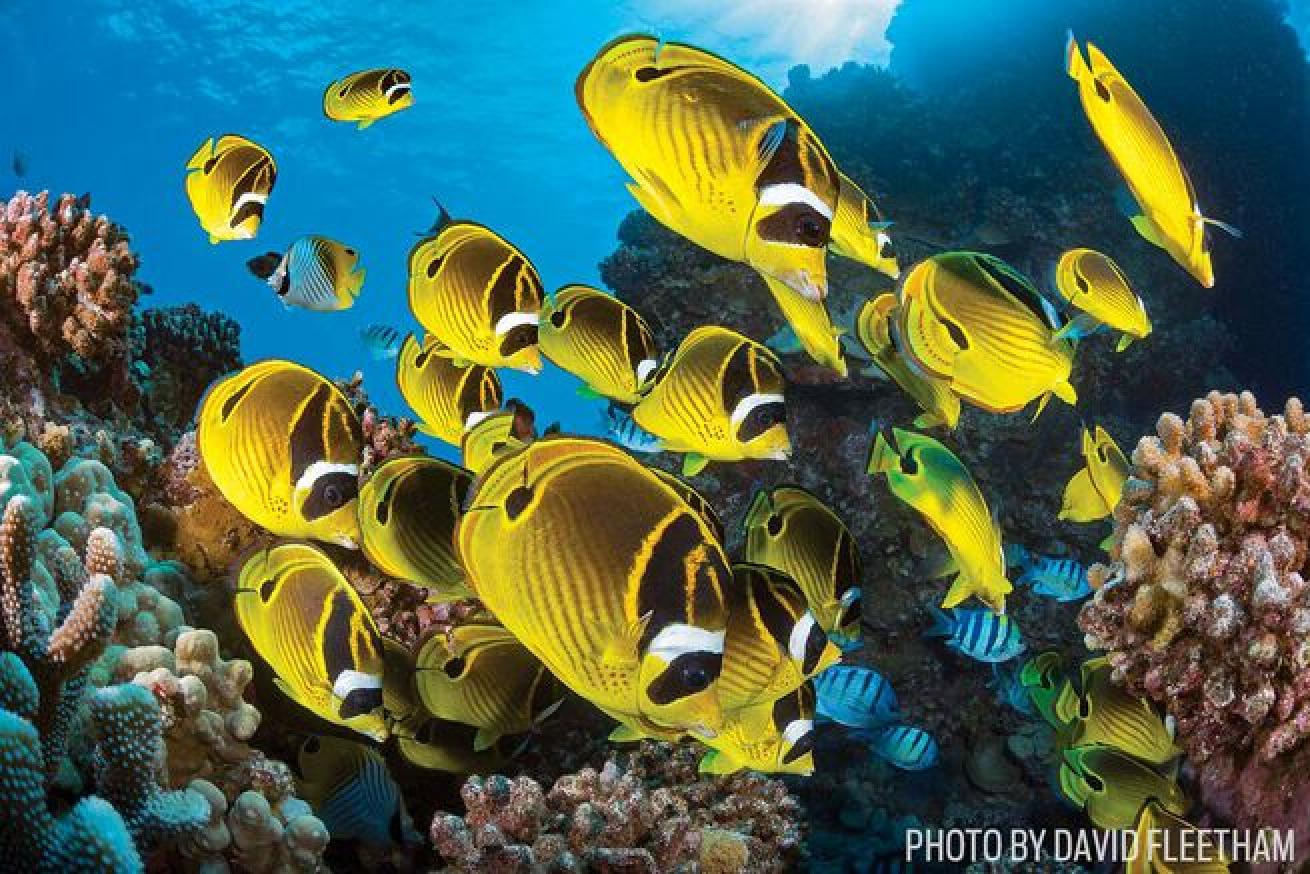
David FleethamSchooling raccoon butterflyfish off the island of Lanai, Hawaii
DIVERS GUIDE TO MAUI
What to wear: 3 mm wetsuit
Average viz: 100 feet
When to go: Year-round, although humpback whale season falls from January through March. Diving and snorkeling with the whales is not permitted, although divers will often hear their haunting songs underwater.
For more info, go to sportdiver.com/maui.
DON’T-MISS DIVES
Monolith This large, rectangular lava pinnacle starts in about 45 feet of water. Often subject to strong currents, the site is appropriate only for experienced divers but offers a rare chance to spot black coral above 150 feet.
Molokini Crater Maui’s most popular dive site offers a shallow, hard-coral garden in the protected bay, as well as adrenaline-pumping drift dives along the back wall. Divers can spot 38 kinds of coral, as well as butterflyfish, Moorish idols, turtles and more.
Second Cathedral The larger of the two cathedrals, this 100-foot-long lava tube offers entrances and exits everywhere. Check out the ceiling of the main chamber for rare black coral — called the chandelier — as well as wrasse, butterflyfish and damselfish.
DIVE OPERATORS
Maui/Hawaiian Rafting Adventures goscubadivemaui.com
Maui Dreams Dive Co. mauidreamsdiveco.com










